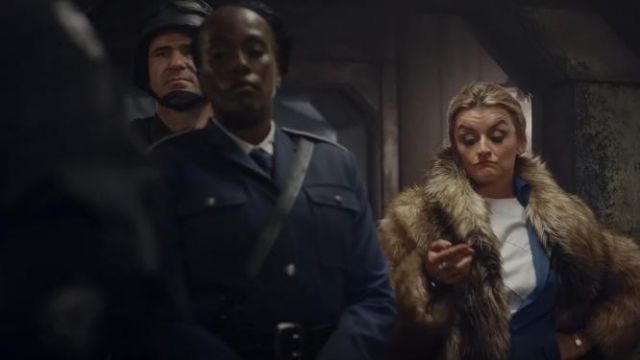AH, Baile Átha Cliath.
Snowpiercer is a TV series set in a dystopian post-apocalyptic future society, based on the 1982 French graphic novel, Le Transperceneige. In this world man-made climate change has entombed the entire planet under ice. In preparation for the impending disaster, a wealthy scientist only known as “Mr Wilford” has developed a never stopping train of 1,001 carriages. Aboard these carriages are farms, animals, and everything needed to survive with a comfortable lifestyle. The series opens with the train standing by as a snow storm rages on. Elements of the wealthiest people in the world who purchased tickets board the train as first class passengers, followed by the second class, third and so on.
In the first class carriages we have the ultra-wealthy, who have access to almost everything, followed around by bodyguards and the “hospitality” staff of the train. In the second class carriages you have the second layer of wealthy people, a sort of upper middle class professional-managerial layer that supplies doctors and other high-ranking staff like security, and they band together with the first carriage. The third carriage are the servants of the first two. They cook their food, clean for them, and perform the bulk service work for the first two carriages.
The twist is that poor people who don’t have tickets break through the barriers, flood the train and end up on board. They stay in the back of the train called the “tail” and are looked down upon by all the other carriages. They’re picked out randomly to do the most undesirable work for the train to keep running, but are kept underfed and in the darkness without even access to windows.
One might think this is unusually cruel and pointless, but then one might think that the capitalist method of organising society is also unusually cruel and pointless. As Fidel Castro said, “why should some drive luxury cars while others cannot eat?”. This is the question you could ask here about the Snowpiercer too. As the first and second carriage have all you can eat buffet style meals, the tail end of the train who number significantly more than the first carriage, are given black jelly like blocks twice a day. Not food, but just enough to get by.

Examine the world around you today. Western countries hoard food, destroy food, throw it out — while half of the world’s population starves. Racists, conservatives and liberals will spew out poisonous lies that underdeveloped countries are the way they are because the people in them are stupider, less educated and not as accustomed to the civilizing effects of capitalism. But in fact the reverse is true, and just like aboard the Snowpiercer, inequality is maintained by the monopoly of violence the ruling class possesses.
The show puts us in the shoes of one man, Leyton, as he’s brought to the head of the train to solve a murder mystery. As he begins to investigate, he figures out that the murderer is actually the accomplice of one of the first class families. There are numerous references to the influence the first class families possess, their power, their money, their organising. Alongside that, the first class families routinely refer in a condescending and derogatory manner to those in the tail end, and lobby for them to be cut loose to die in the ice. This is not so different to the comments members of Fine Gael hurled at young CYM members when the organisation disrupted their meeting on International Workers Day in 2019. They shouted “Have ye jobs? where are you from?” and so on. Whether intentional or not, Snowpiercer displays unflinchingly the disgust that the ruling class have for the rest of us.
The last available episode at the time of writing, episode 5, brings us to Leyton, the main protagonist finding out who the murderers are and bringing them for trial. In between this, we see a few different plots develop. The first main one is that the Nightcart, which functions as a sort of nightclub/brothel cart, engages in a petition to have their cart and section represented at the judicial panel for the culprits. The management of Snowpiercer concedes this demand, and it seems that progress is being made. The second main point, which might not be important but remains interesting is the fact that one character, a guard, and another, a scientist, move in together. The guard is moving up from her quarters in a third carriage and is therefore rising in social status. As she discusses this with her colleague, he makes the very specific comment that “you’re now part of the bourgeoisie”. This is a common misconception among us to this day. Working class people who do a little better for themselves, own their home, etc. see themselves as apart from the working class and understand their identity to be “middle class”, even though they would fall into poverty if they suddenly stopped selling their labour. Snowpiercer is a class conscious film that gives many nods to the social structure of the train. The politics are so openly engrained in the thematic presentation that ignoring them and treating it like a crime drama would be impossible.
The final main point is the on-going commentary regarding Leyton. He meets other people from the tail end who have settled in the third carriage, who now do waitering work or other services for the ultra-wealthy and they all expect him to settle there with him. His demand remains simple, he is of the tail, he wants to return to the tail, and his scheme is straightforward, he wants a revolution for the tail. This suggests a little commentary as to how splintered and often desperate the left is. Some elements of it, the small few, remain true to the cause of complete revolution, while many others, defeated, exhausted and fatigued by struggle, settle for something slightly less worse than the tail. Just like now, we see some leftists accept well paid professions and slowly drift away from their own class and existing almost exclusively within their own inert and stagnating circles.
Just like now, we see the struggle by a slim minority of us to maintain, sustain and develop an organic link to our class and ultimately facilitate the empowerment and emancipation of our class. To stay true to our cause and not compromise midway for a slightly more alluring lifestyle.

Despite that, the truth of the matter is that working class people with their own home and car are still working class. They still serve capital and still sell their labour power, just for slightly better hours and slightly better pay. Episode 5 ends with the trial of the murderers occurring. The tribunal, which is composed of first, second and third carriage representatives finds the culprit guilty. At the last minute, Mr Wilford, the unelected executive owner of the train commutes the sentence, overriding the will of the tribunal and spitting in the face of even symbolic justice.
Is this any difference to the State Attorney making a deal with Jeffrey Epstein? Is this any different to the absence of any real convictions for the destruction of Ireland during the 2008 crisis and resultant bailouts? No, it isn’t, and Snowpiercer accurately portrays the absence of justice inside a train, modelled on the old capitalist world. We want to build a new world, where justice is served for all and human beings live a life of dignity. The Tail is coming for the ruling class, in the Snowpiercer, and out here.

